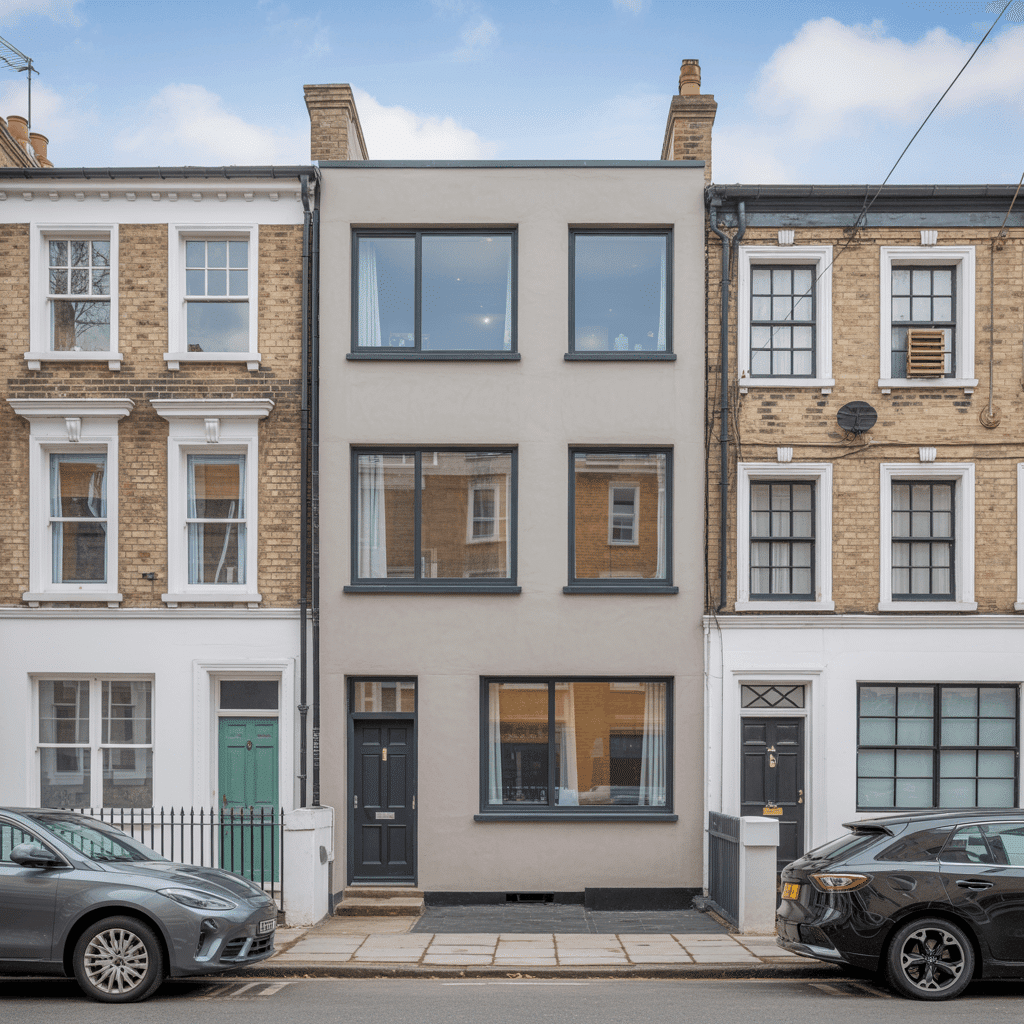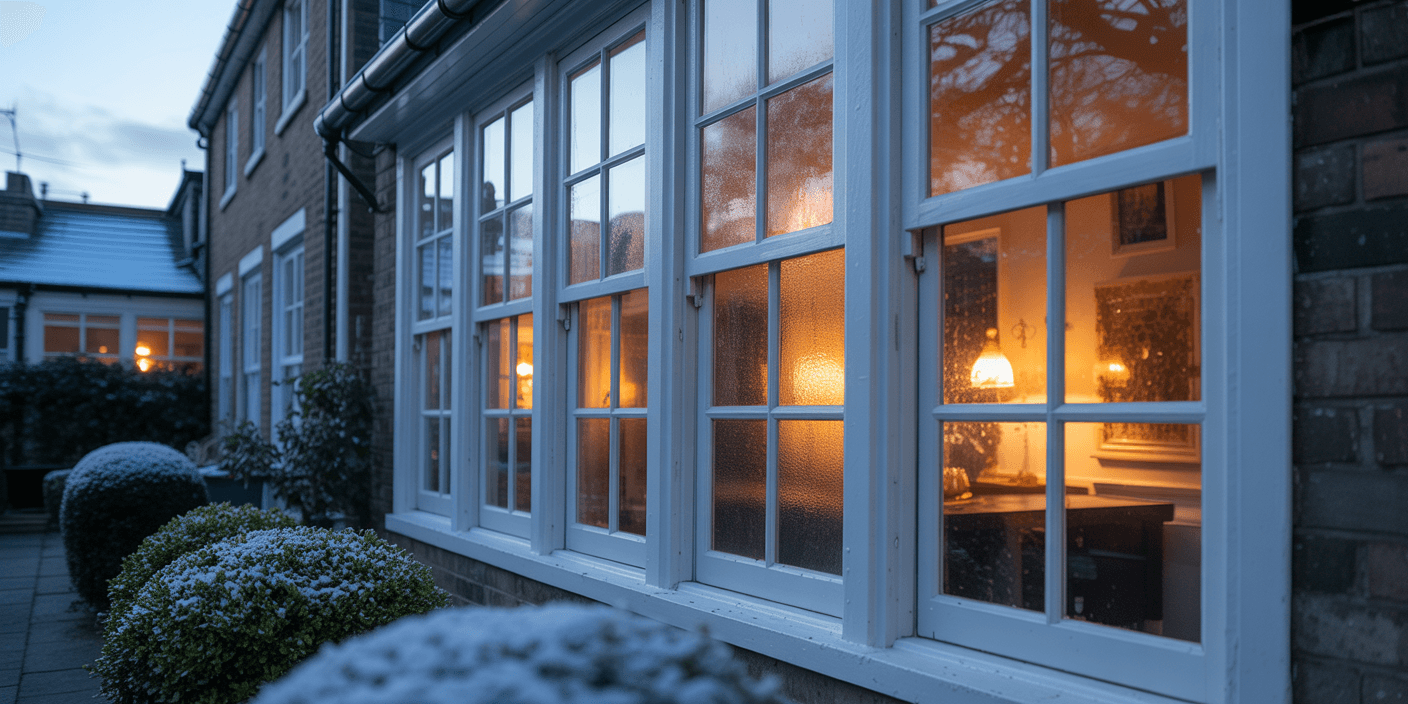The Heat Problem You Didn’t Realise You Had
A well-insulated home should be comfortable year-round. Yet across the UK, beautifully appointed properties—often equipped with modern double or triple glazing—are increasingly uninhabitable during warmer months. The reason is not simply the rising temperature. It is the way windows respond to it.
Most British homes were built to retain heat. In winter, this is desirable. In summer, it becomes a liability. South- and west-facing rooms regularly exceed 28°C during a moderate heatwave. Cooling systems are overworked. Fabrics deteriorate. Thermal comfort collapses.
The common denominator? Fenestration.
Windows can account for up to 50% of solar heat gain in a domestic property. Even premium glazing becomes a passive radiator if installed without regard for orientation, shading, or thermal bridging. Air-conditioning, while increasingly relied upon, only treats the symptoms—at significant financial and environmental cost.
There is another approach. One that reduces internal temperatures without mechanical intervention, by designing windows not simply as visual features, but as active components of the home’s thermal strategy.
This is where expert firms such as Sash Windows London distinguish themselves. Their work does not begin with aesthetics. It begins with physics—sun paths, air movement, and insulation dynamics. The result is a window system that does more than insulate. It regulates. It protects. It performs.
Passive Cooling Isn’t a Trend — It’s a Strategy
Air‑conditioning is a sticking plaster. Passive cooling is a blueprint. It’s not new, not experimental, and certainly not a fad. Long before compressors and refrigerants, architects used orientation, shading, and airflow to keep grand houses cool. What we now call “passive” was simply good design.
At its core, passive cooling means reducing indoor heat gain without mechanical input. Instead of paying to expel hot air, you prevent it from entering in the first place. You block high summer sun but invite low winter light. You draw breezes through the building and let thermal mass soak up and release cool air overnight. You’re not cooling a box; you’re orchestrating a climate.
It’s a measurable science. Orientation, glazing type, U‑values, and shading coefficients can be calculated to within a decimal point. Properly executed, passive cooling can reduce peak indoor temperatures by several degrees and cut cooling energy demand by more than half.
This is where Sash Windows London thrives. While others simply sell “energy‑efficient windows”, their team designs entire fenestration systems as passive instruments. Sightlines, sash operation, and frame materials aren’t just aesthetic choices — they’re thermal levers. By applying these principles to both period properties and contemporary builds, they turn a vulnerable surface into an invisible shield.
Passive cooling isn’t a lifestyle choice. It’s the difference between a house that fights the weather and one that works with it. And it begins, quite literally, at the window.
Why Window Design Is the First Line of Defence

Most people think of windows as decorative—something to frame a view or add light to a room. But in summer, they become portals for heat. Left unchecked, they are the largest unintentional contributor to overheating in a home.
In a typical south‑ or west‑facing room, poorly designed windows can raise internal temperatures by as much as 6°C during a heatwave. Even so‑called “energy-efficient” double glazing offers little defence if it’s installed in the wrong place, fitted with the wrong glass, or sealed with the wrong frame.
Three variables matter more than most:
- Orientation: Where the window faces dictates how much direct sun it receives and when.
- Glazing composition: Not all triple glazing is equal. Solar gain, U-values, and spectrally selective coatings make a dramatic difference.
- Frame material: Aluminium without a thermal break can become a heat conduit. Timber, when properly engineered, insulates passively.
But design isn’t only about materials. It’s about intention. A well-planned window resists summer sun but welcomes winter light. It opens where air wants to flow. It casts shade where it counts and vanishes into the wall when it doesn’t.
This is where the craftsmanship of Sash Windows London quietly comes to the fore. Their systems don’t just look right—they perform right. By aligning glass type, sash mechanics, seal integrity, and visual proportions with your property’s thermal strategy, they turn every window into an energy-saving mechanism.
In modern buildings, it’s not walls or roofs doing the most work. It’s the windows. And when they’re designed as defensive architecture, passive cooling becomes not only possible, but effortless.
Orientation: The Hidden Power of Placement
You could have the best glazing on the market — triple-sealed, argon-filled, thermally broken — but if the window faces the wrong direction, you’re still letting the sun punch holes in your cooling strategy.
Orientation isn’t a detail. It’s destiny.
Windows that face south collect steady, strong sunlight from mid-morning through late afternoon. Windows facing west catch the brutal low-angle sun at its hottest. That’s why west-facing bedrooms often feel like ovens by 6 p.m., even in a British summer.
By contrast, north-facing windows offer ambient light with minimal solar gain, and east-facing glass gives you cooler morning sun before the heat builds.
Smart passive cooling starts by understanding this solar geometry — and then using it to your advantage. Here’s how it works in practice:
- On south-facing elevations, you can introduce shallow overhangs or deep window reveals that block high summer sun while still allowing winter warmth to enter.
- On west-facing facades, external shutters or adjustable louvres become essential, shielding interiors during the most punishing hours.
- On the north side, smaller fixed panes or high-performance units preserve daylight without adding unwanted heat.
Sash Windows London brings these principles to life not only through technical design but through deep architectural sensitivity. In conservation zones or heritage properties, where repositioning is impossible, they adapt window geometry, depth, and shading to simulate orientation control — achieving passive effects without altering façades.
Orientation is more than where a window faces. It’s how it responds to the sun. Every degree matters. Every reveal, sill, and shadow line plays a part.
Get this right, and your windows don’t just admit light — they block heat. Get it wrong, and you’ll spend years trying to cool what you could’ve simply designed to stay calm.
Shutters, Louvres & Smart Shading Systems
Before air-conditioning, there were shutters. Before overheating became a planning issue, louvres quietly protected homes from harsh sun. These elements weren’t decorative. They were functional armour — the original passive cooling technology.
Today, their purpose is more critical than ever.
As glazing areas grow larger and homes become more airtight, the shading strategy becomes the decisive factor in summer comfort. Even high-performance glazing can let in unwanted heat if left exposed. Shutters and louvres solve this at the source — intercepting solar gain before it hits the glass.
The Science of Shade
External shading is up to 4× more effective than internal blinds. Why? Because once sunlight penetrates the glazing, it’s already inside the thermal envelope. Your only option then is to expel it — at a cost.
But a well-placed timber shutter, a vertical brise soleil, or even a carefully recessed reveal stops the heat before it starts. It reflects, absorbs, or channels the sun’s rays away from sensitive interiors. That’s free cooling, engineered.
Heritage Meets High Performance
Shutters are often dismissed as quaint relics of a past aesthetic. But Sash Windows London treats them as precision tools. On listed properties, their timber sash shutters are bespoke-crafted to echo period detail while delivering modern insulation value.
They understand that elegance doesn’t have to fight function. Their designs allow for:
- Operable internal or external shutters
- Period-correct timber louvres
- Integrated cavity shutters with improved U-values
- Automated solar louvre systems on contemporary builds
These aren’t tacked-on accessories. They’re strategic, thermally calculated, and tailored to the window’s orientation and exposure.
Shading Is Passive Intelligence
The goal is simple: block high-angle summer sun while admitting low winter light. A fixed overhang does this. So do adjustable shutters. So does intelligent window placement.
And it all begins with one question: What will this window face in July at 3 pm?
With the right answer, you don’t need air-con. You need smart shade.
The Science of Airtightness and Thermal Mass

Cooling isn’t only about keeping heat out — it’s also about what happens once it’s inside. That’s where two silent forces come into play: airtightness and thermal mass. Together, they determine whether your home stays calm in the face of rising temperatures — or turns into an oven with a roof.
Airtightness: Your Invisible Shield
Most homes leak — not just heat in winter, but cooled air in summer. Even small gaps around window frames, sashes, or glazing junctions allow warm air to creep in, especially under solar pressure.
When your windows are leaky, your passive cooling is compromised before it begins.
This is where Sash Windows London excels in ways most glazing suppliers don’t. Their installations are not just fitted — they are sealed. Every joint, junction, and sash closure is designed for low air permeability, verified with blower door standards. That means:
- No draughts in winter
- No infiltration in summer
- No energy wasted at all
Airtightness is measured in m³/hr/m². Lower is better. Sash Windows London routinely delivers airtightness levels exceeding new-build compliance targets — in properties over 100 years old.
Thermal Mass: Nature’s Cooling Battery
Walls, floors, and internal masonry can absorb heat during the day and release it when temperatures drop — if the home is properly ventilated. However, this mechanism only works when cool air is allowed in overnight and warm air is effectively purged.
This is where window operability becomes vital.
Top and bottom sash openings create a stack ventilation effect, drawing cool night air in low and pushing hot air out high. Unlike modern tilt-turns or fixed units, sash windows can breathe. And when coupled with cross-ventilation from other rooms, you achieve a passive air cycle — no fans required.
Sash Windows London respects this legacy — and modernises it. Their systems combine traditional ventilation logic with modern seals and balances, so you gain performance without sacrificing elegance.
Precision, Not Guesswork
Passive cooling only works when airtightness and thermal mass are in harmony. Without airtight windows, heat seeps in. Without operable, well-placed openings, heat gets trapped.
With the right window system, they become partners in comfort — one stopping the ingress, the other absorbing what remains.
This isn’t aesthetics. It’s physics, dressed in craftsmanship.
Real Results: A Passive Cooling Window Retrofit in Action
The house was beautiful — and unbearable in summer.
A three-storey Georgian townhouse in West London, Grade II listed, with original timber sashes, south-facing drawing rooms, and a rear kitchen extension flooded with glass. In winter, it radiated charm. In summer, it radiated heat.
By July, upstairs bedrooms routinely reached 29°C by nightfall, even with blackout blinds drawn and ceiling fans running. The homeowners — professionals with two young children — were contemplating mechanical cooling. A full AC install. Ducting, compressors, the works.
Instead, they called Sash Windows London.
The Assessment
Our team performed a full passive cooling audit — analysing sun paths, orientation, existing U-values, infiltration points, and internal airflow. The diagnosis was clear:
- Original single-glazed sashes were acting as solar collectors
- Loose frames were allowing warm air ingress throughout the day
- No cross-ventilation existed between the front and rear rooms
- The south-facing elevation was unshaded and overexposed
The Solution
We proposed a passive cooling retrofit that respected the building’s heritage status while transforming its thermal profile:
- Installed slimline, vacuum-glazed heritage sash units with ultra-low U-values
- Retrofitted internal sash shutters on all south-facing windows, custom-built to period dimensions
- Improved airtightness using brush seals, concealed draught strips, and perimeter insulation
- Reconfigured sash operability to enable night-flush stack ventilation
- Coordinated with conservation officers to ensure full listed-building compliance
The Results
Within the first 30 days of warm weather:
- Peak summer room temperatures dropped by 4.2°C (from 29.1°C to 24.9°C)
- Night-time cooling improved by 38%, verified via data-logging sensors
- No air-conditioning required, even during the August heatwave
- EPC rating improved by two grades, increasing property resale value
- Period aesthetics preserved; conservation approval passed on first submission
But perhaps the most telling result?
“We no longer dread the summer,” said the homeowner. “Our home is cooler, quieter, and more comfortable — and we didn’t have to compromise a single window.”
This is what passive cooling looks like in practice. It isn’t just insulation or solar glass. It’s an intelligent window design, backed by architectural empathy, thermal science, and meticulous craftsmanship.
Want Passive Cooling? Start with Your Windows.
If your home overheats in summer, the problem likely isn’t your insulation. It isn’t your curtains. It may not even be your glazing.
It’s your windows — how they’re placed, how they breathe, how they block or welcome the sun.
Passive cooling is a design decision. And like all good decisions, it starts with knowledge. With craft. With systems designed not just to look right, but to think ahead.
At Sash Windows London, we’ve spent decades restoring, reimagining, and refining windows for Britain’s most sensitive homes — from Georgian terraces to ultra-modern extensions. We understand orientation, heritage, and thermal performance not as separate challenges, but as one integrated opportunity.
And now, we bring that same precision to passive cooling.
Before you install ductwork, buy another fan, or give up on summer comfort, start with what’s already there. Start with your glazing. Start with design.
Start with us.
👉 Book a Passive Cooling Window Audit with Sash Windows London
Discover how your windows could help you cool naturally, quietly, and beautifully — without compromising character or compliance.







